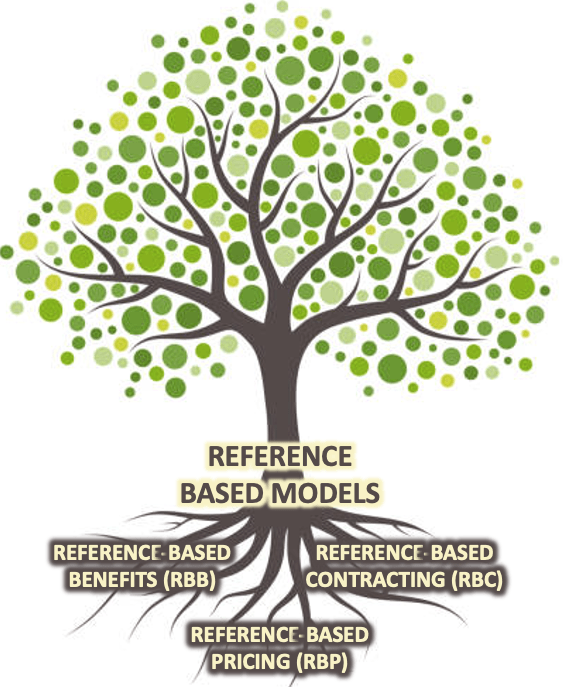Reference-based models address the root cause of high health care costs: the prices.
Studies of health care costs reaffirm the following adage time and again: prices, not utilization, drive health care cost inflation. Data from The Health Care Cost Institute confirm that increased prices accounted for 75% of per person health care cost increases over the past five years. Meanwhile, the most recent report from the RAND Corporation’s Hospital Price Transparency study demonstrates that the gap between Medicare and Commercial rates continues to widen year over year: in 2018, hospitals’ average commercial prices grew to 247% of Medicare, up 17 points from the previous year.
It’s no wonder then that employers and other health care purchasers are eager for solutions that attack health care cost inflation at its root cause. One prominent strategy is using reference-based pricing (RBP) models that anchor commercial rates to Medicare, or some other rationalized external benchmark. Like so many health care innovations, reference-based frameworks encompass multiple branching models. As such the term “RBP” has come to mean different things to different stakeholders. 
In this blog post, we explore three different reference-based models:
- Reference-based Benefits – which sets a maximum allowed benefit for elective procedures
- Reference-based Contracting – which anchors provider contracts to Medicare rates
- Reference-based Pricing – a vendor-convened model that also anchors provider prices to Medicare, with or without a formal contract in place
Reference Based Benefits (RBB) – Setting a benefit maximum for elective procedures
In 2011, the California Public Employees’ Retirement System (CalPERS) surveyed prices for joint replacement surgery across the California marketplace. It found a 7-fold difference in prices for the procedure without any correlation to quality outcomes. To reduce spending, CalPERS set a threshold benefit level of $30,000, and identified 46 hospitals state-wide that accepted this reference price or less for joint replacement. If a member selected a higher-cost hospital, CalPERS paid the first $30,000, but required the plan member to cover the difference out-of-pocket. After the first year, CalPERS achieved program savings of $2.8M, an average savings of $7,000 per patient, without any detriment to clinical quality outcomes. Moreover, the program spurred hospital competition: several hospitals whose prices were above the $30,000 reference price voluntarily renegotiated their contracts so that they could meet the threshold and continue to receive CalPERS plan members.
The CalPERS RBB model showed tremendous promise, but it was complex to administer and required members to act as informed and engaged health care consumers. And the complexity multiplies as purchasers add additional elective procedures that are subject to a reference price. If members don’t research provider prices in advance, the results could be financially devastating.
That is why the newest rendition of reference-based benefits, as profiled in CPR’s case study of the Self-Insured Schools of California, focuses on site of service instead of specific providers. SISC identified five elective procedures (arthroscopy, cataract surgery, colonoscopy, upper GI endoscopy with or without biopsy) and applied a reference benefit only if plan members receive these procedures in a hospital-based setting. Because the benefit design applies to site of service rather than procedure price, it’s easier for members to navigate. As of July 2020, the program has saved over $3M, with less than 0.2% of members incurring additional charges for using hospital-based facilities.
Reference Based Contracting (RBC): Anchoring hospital contracts to Medicare rates
In Montana in 2016, Marilyn Bartlett, the administrator of the Health Care and Benefits Division for Montana’s state employee health plan, informed hospitals that the state’s plan would pay a maximum of 230% of Medicare rates, and that any hospital unwilling to accept these rates would be excluded from the state employee health plan network. With its 33,000 covered members, the State of Montana’s employee health plan represented business hospitals couldn’t afford to lose. Eventually, every hospital in the state signed on. As a result, health plan co-pays and premiums remained completely flat since the program launched in 2016.
Reference-based contracting found success in Montana, where hospital competition creates a credible threat of lost market share, and where the state’s employee health plan represents a significant portion of commercial volume. But the majority of US health care markets lack robust provider competition, and most health care purchasers don’t have sufficient volume to negotiate an RBC strategy with local hospitals. As such, the RBC strategy is likely outside the grasps of most purchasers.
However, the third reference-based model, reference-based pricing, is accessible to purchasers of all sizes and scale.
Reference Based Prices (RBP) – Like Reference Based Contracting, minus the contract
Within the past decade, a new reference-based model has been slowly gaining traction: reference-based pricing (RBP). Under RBP, self-insured purchasers contract with vendors to re-price claims at a multiple of Medicare’s rates, usually somewhere between 140-180%. As such, these vendors take over the claims adjudication functions – typically the purview of third-party administrators – and pay providers at Medicare-referenced rates with or without a contract. Providers either accept the payment (which is usually much lower than what they would receive from a commercial health plan) or they don’t, in which case the provider may balance bill the patient for the remainder. If a patient is balance billed, the RBP vendor has a reserve army of advocates and legal representatives that fights or negotiates with the provider on the patient’s behalf until they reach a settlement.
Many vendors attempt to reduce balance billing by guiding patients to “safe harbor providers” –providers with whom the vendor has negotiated a contract, or that the vendor knows will accept the reference price. RBP vendors aim to reduce the cost of care at its root: prices, and many also claim significant savings through careful scrutiny, editing, and auditing of all large claims.
Ready to learn more?
In April 2021, CPR hosted a Virtual Summit to explore the depths of the RPB, the newest of the reference-based models. The Summit tackled complex questions to understand how or why a RBP program works, such as:
- Why are providers willing to accept rates from RBP vendors that are half as much as they could receive from a national carrier?
- How do RBP vendors think about clinical outcomes, care experience and value-based contracts?
- What are the compliance and regulatory issues purchasers need to consider when deciding whether to implement RBP, and selecting an RBP vendor?
It also included two exclusive panel discussions. One with RBP experts to identify what’s signal and what’s noise in the RBP space, and another with purchasers who have successfully launched a RBP program.
At CPR, we’ve been beating a loud drum to the tune of “It’s not payment reform if it doesn’t address prices.” Now RBP vendors present the opportunity to address inflated health care prices at their root. But operating a health plan without a contract can feel like jumping off a high cliff without a parachute. The question is: should purchasers take the leap? Watch the Virtual Summit recording or download our free report to judge for yourself.
Photo by Jeremy Bishop on Unsplash.

